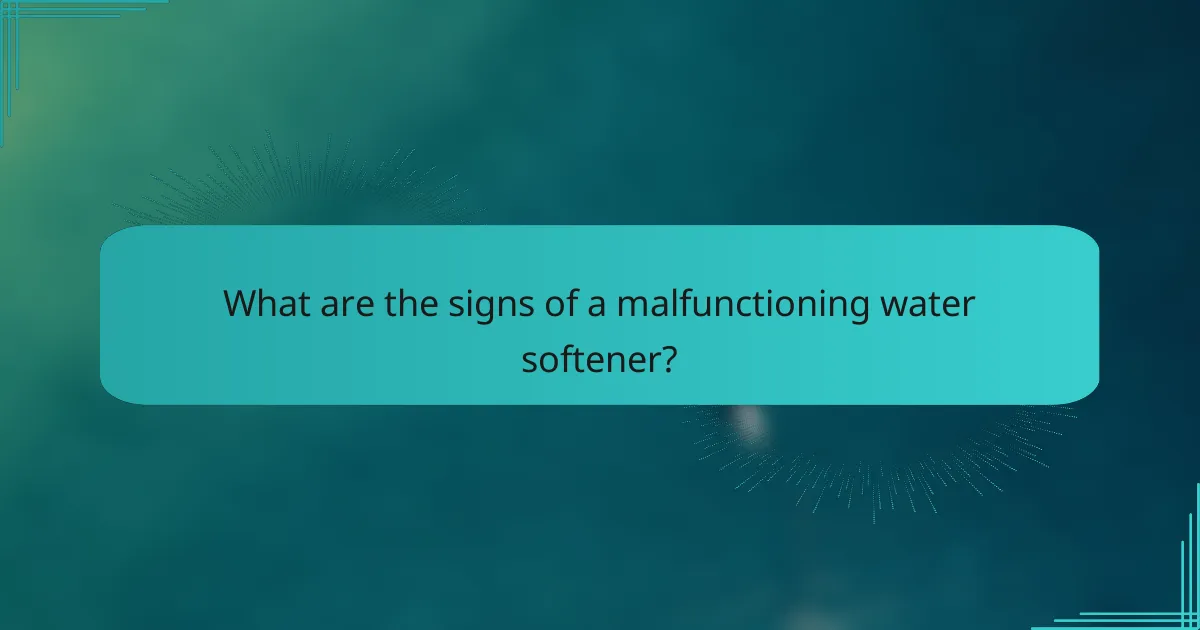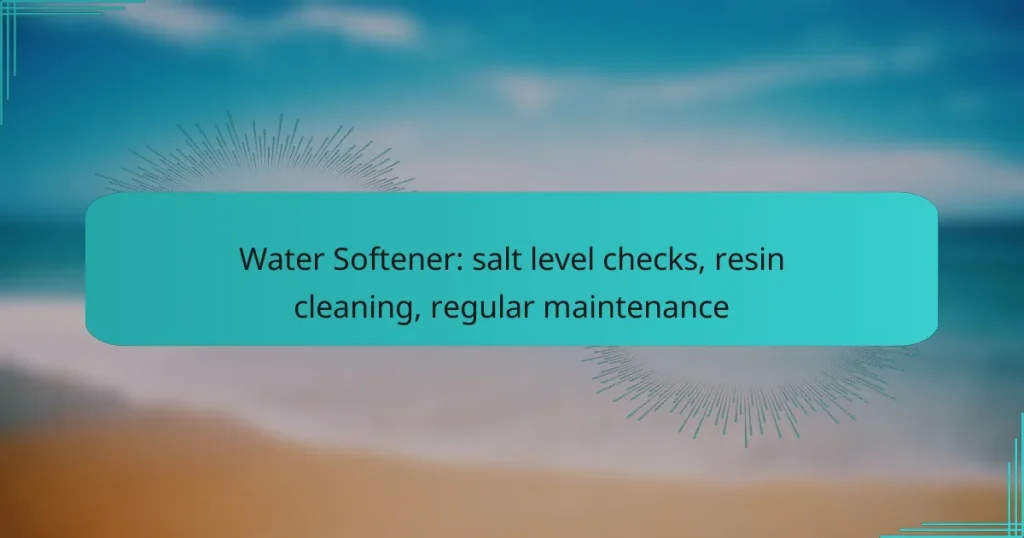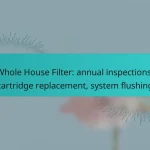Maintaining a water softener is crucial for ensuring its efficiency and longevity. Regularly checking salt levels, cleaning the resin, and performing routine maintenance tasks can prevent hard water issues and enhance the system’s performance. By staying proactive with these tasks, you can enjoy the benefits of softened water while extending the life of your water softener.

How to check salt levels in water softeners?
To ensure optimal performance, regularly checking salt levels in water softeners is essential. Maintaining appropriate salt levels helps prevent hard water issues and extends the life of the system.
Use a salt level gauge
A salt level gauge is a convenient tool that provides a quick reading of the salt levels in your water softener. Many modern systems come equipped with this feature, allowing you to monitor levels without opening the tank.
If your water softener does not have a built-in gauge, consider installing one. These gauges are typically easy to install and can save you time and effort in maintenance.
Visual inspection of salt tank
When inspecting, also check for any clumping or bridging of the salt, which can hinder the softening process. If you notice any issues, break up the salt or replace it as necessary.
Check manufacturer guidelines
Consulting the manufacturer guidelines is crucial for understanding the specific salt level requirements for your water softener model. Each system may have different recommendations regarding salt types and optimal levels.
These guidelines often include maintenance schedules and tips for troubleshooting common issues. Following them can help you avoid costly repairs and ensure your water softener operates efficiently.

What is the process for cleaning resin in water softeners?
Cleaning resin in water softeners involves several steps to ensure the resin beads effectively remove hardness minerals from water. Regular maintenance, including backwashing and using cleaning solutions, helps maintain the efficiency of the resin bed.
Backwashing the resin bed
Backwashing is a crucial step in cleaning the resin bed of a water softener. This process involves reversing the flow of water through the resin tank to dislodge trapped particles and sediment. Typically, backwashing should be performed every few weeks, depending on water quality and usage.
To backwash, set the water softener to the backwash mode and allow it to run for a specified duration, usually around 10-15 minutes. This helps ensure that the resin remains free from debris and functions optimally.
Using resin cleaning solutions
Resin cleaning solutions are specially formulated chemicals designed to remove iron, manganese, and other contaminants from the resin beads. These solutions can be added during the regeneration cycle of the softener, enhancing the cleaning process.
When using a resin cleaning solution, follow the manufacturer’s instructions for dilution and application. Typically, this involves mixing the solution with water and allowing it to circulate through the resin bed for a set period, often around 30 minutes to an hour.
Frequency of resin cleaning
The frequency of resin cleaning depends on water quality and usage patterns. For households with hard water or high iron content, cleaning may be necessary every few months. In contrast, areas with softer water may require less frequent cleaning.
As a general guideline, inspect the resin bed every 3-6 months and clean it if you notice reduced efficiency or increased hardness in the water. Regular checks can help maintain optimal performance and prolong the life of the water softener.

What are the regular maintenance tasks for water softeners?
Regular maintenance tasks for water softeners include inspecting and replacing filters, checking for leaks and corrosion, and scheduling professional maintenance. These tasks ensure the system operates efficiently and prolong its lifespan.
Inspecting and replacing filters
Inspecting and replacing filters is crucial for maintaining water softeners. Filters trap sediment and impurities, preventing them from entering the system and affecting performance. Depending on usage, filters should typically be checked every few months and replaced annually.
When replacing filters, ensure you use the correct type specified by the manufacturer. This helps maintain optimal water quality and system efficiency. Regular checks can also prevent clogs that may lead to costly repairs.
Checking for leaks and corrosion
Regularly checking for leaks and corrosion is essential to prevent water damage and maintain the integrity of your water softener. Look for signs of moisture around the unit and inspect the pipes and connections for any corrosion or wear.
If you notice any leaks, address them immediately to avoid further damage. Corroded parts should be replaced promptly to ensure the system remains effective and safe. Keeping a close eye on these components can save you from expensive repairs down the line.
Scheduling professional maintenance
Scheduling professional maintenance is a key aspect of water softener upkeep. Experts can perform thorough inspections and maintenance tasks that may be difficult for homeowners to manage. Aim for professional servicing at least once a year to ensure optimal performance.
During these visits, professionals can clean the resin bed, check salt levels, and calibrate the system. This proactive approach not only enhances efficiency but also extends the lifespan of your water softener, ensuring you get the best value from your investment.

What are the signs of a malfunctioning water softener?
Signs of a malfunctioning water softener include increased hardness in water, salt bridge formation, and unusual noises during operation. Recognizing these indicators early can help prevent further issues and maintain the efficiency of your system.
Increased hardness in water
If you notice that your water feels hard, with a soapy residue or scale buildup on fixtures, your water softener may not be functioning properly. This can happen when the resin beads become saturated or damaged, reducing their ability to remove minerals like calcium and magnesium.
To check for hardness, you can use a water hardness test kit available at home improvement stores. Regular testing can help you determine if your softener needs maintenance or if the resin needs replacement.
Salt bridge formation
A salt bridge occurs when a solid mass of salt forms in the brine tank, preventing the salt from dissolving in the water. This can lead to insufficient regeneration of the resin beads, causing hardness to return in your water.
To identify a salt bridge, tap the side of the brine tank; if you hear a hollow sound, a bridge may be present. Breaking up the bridge with a broom handle or similar tool can resolve the issue, but regular checks of the salt level can help prevent this problem.
Unusual noises during operation
If your water softener is making unusual noises, such as gurgling, hissing, or grinding, it may indicate a malfunction. These sounds can result from air trapped in the system, a malfunctioning valve, or issues with the motor.
Listening for these noises during the regeneration cycle can help you pinpoint the issue. If the noises persist, consider consulting a professional to diagnose and repair the system, as ignoring them may lead to more significant problems.

How often should water softeners be serviced in the UK?
Water softeners in the UK should ideally be serviced every 12 months to ensure optimal performance and longevity. Regular servicing helps maintain the system’s efficiency and prevents issues such as salt bridging or resin fouling.
Annual maintenance recommendations
Annual maintenance for water softeners typically includes checking the salt level, cleaning the resin, and inspecting the system for any leaks or wear. It’s advisable to replace the resin every 5 to 10 years, depending on usage and water quality.
During the service, ensure that the brine tank is cleaned to prevent buildup and that the control head is functioning correctly. Regularly topping up the salt and monitoring the system can help avoid costly repairs later.
Factors affecting service frequency
Several factors can influence how often you need to service your water softener. These include the hardness of your water, the volume of water used, and the type of softener system installed. Harder water may require more frequent servicing due to increased mineral buildup.
Additionally, households with higher water consumption or those with multiple bathrooms may need to check their systems more often. Regular monitoring of performance indicators, such as water quality and flow rate, can help determine the appropriate service schedule for your specific situation.

What are the costs associated with water softener maintenance?
The costs of water softener maintenance can vary significantly based on service type and frequency. Regular checks, resin cleaning, and salt level monitoring are essential to ensure optimal performance and longevity of the system.
Average service costs in the UK
In the UK, the average cost for professional water softener maintenance can range from £50 to £150 per visit, depending on the service provided. Routine checks and salt replenishment are typically on the lower end of this scale, while more extensive services, such as resin cleaning, may cost more.
Many homeowners opt for annual maintenance contracts, which can provide savings over individual service calls. These contracts often include regular inspections and discounts on parts and labor, making them a cost-effective choice for long-term upkeep.


